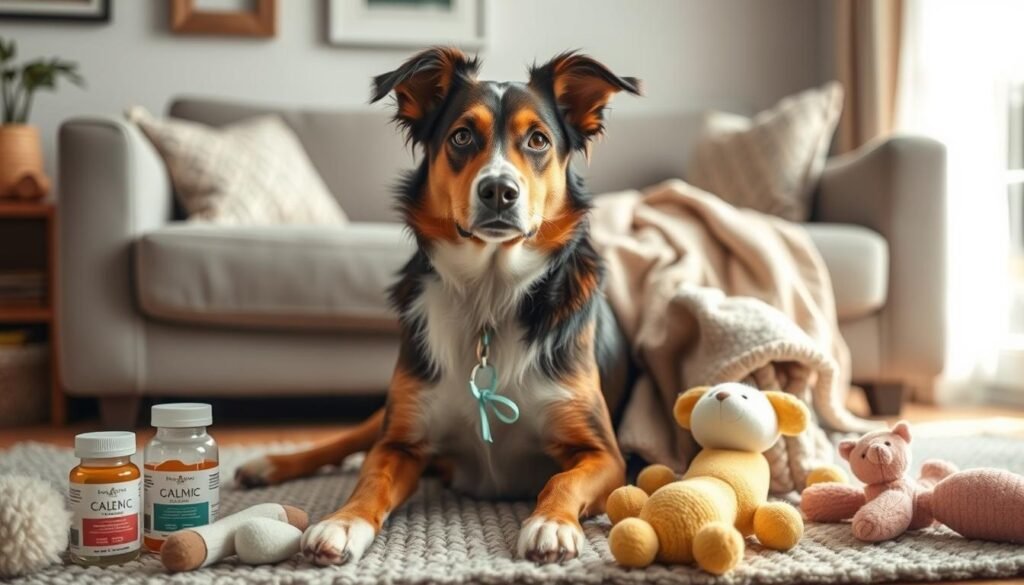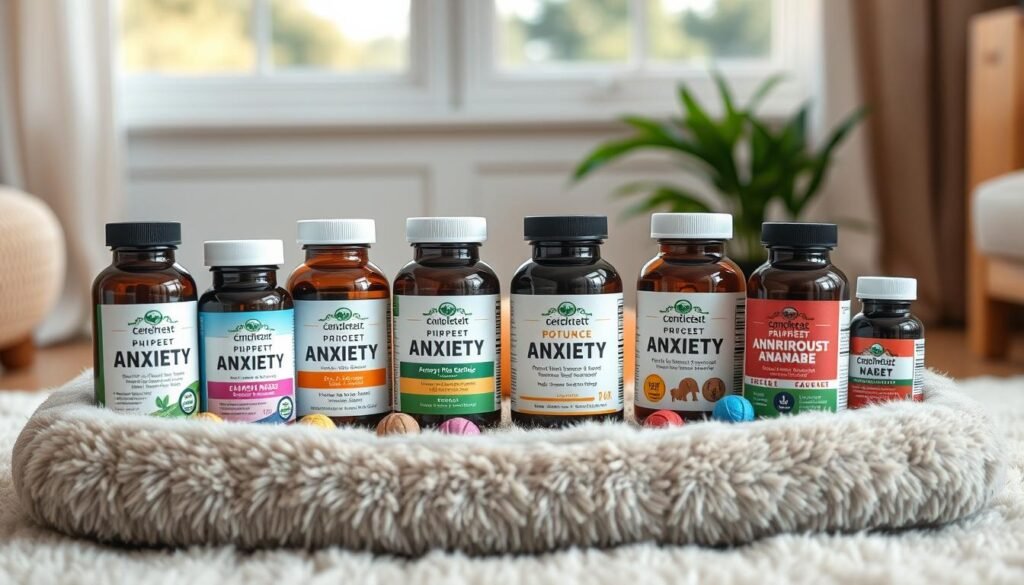Did you know that dogs can feel anxious for months or even years? This can hurt their overall happiness and health. Like people, dogs deal with anxiety, fear, stress, and even mental health drops. They can feel scared when alone or stressed out. Luckily, there are good ways to help them feel calm. In this article, we look at different calming solutions for dogs. You’ll learn about symptoms, treatment choices, and natural fixes. These can make your pet’s life better and more balanced.
It’s important to know the signs of anxiety in dogs and how to help. There are many dog anxiety medication options. We’ll talk about both standard treatments and holistic approaches. This guide will help you make smart choices for your dog’s mental well-being.
Learn more about calming solutionsfor.
Key Takeaways
- Anxiety in dogs can last a long time and needs proper handling.
- Dog anxiety can come from fear, stress, or being apart from you.
- Finding anxiety signs early helps in treating them better.
- Talking to a vet is crucial for choosing the right anxiety med for dogs.
- Meds and behavior changes together often work best.
- Natural methods, like CBD and scents, can also soothe your dog.
- Playing and training regularly can help lower their anxiety.
Understanding Dog Anxiety
Dog anxiety comes from many triggers that affect their emotions. Knowing the causes of dog anxiety helps in preventing and treating it. Anxiety can be due to loud noises, new places, or bad past experiences. Learning about these can help pet owners care for their pets better.
Common Causes of Anxiety in Dogs
Many factors can make dogs anxious. These include:
- Separation Anxiety: About 14 percent of dogs get anxious when left alone. This can lead to them acting out or barking a lot.
- Noise Sensitivity: Being scared of loud or sudden sounds can stress dogs out.
- Environmental Changes: Moving or a shift in their routine can make dogs anxious.
- Past Trauma: Bad experiences in the past can cause fear and anxiety.
- Cognitive Dysfunction Syndrome (CDS): Aging dogs might get anxious due to changes in their brains.
Knowing these triggers can help in finding natural and behavioral ways to treat dog anxiety.
Signs of Anxiety in Dogs
Seeing the signs of anxiety in dogs means you can help them faster. Signs to watch for include:
- Loud barking, howling, or whining when they are alone
- Walking around a lot or seeming uneasy in scary situations
- Chewing or scratching things around the house
- Panting or drooling more than usual without being active
- Trying to hide or staying close to their owners when scared
Keeping an eye on these signs helps owners know when their dogs are stressed. This way, they can figure out the best way to help them.
| Type of Anxiety | Common Symptoms |
|---|---|
| Separation Anxiety | Whining, house soiling, destruction |
| Noise Sensitivity | Panting, hiding, shaking |
| Aggressive Behavior | Growling, lunging, snapping |
| Cognitive Dysfunction Syndrome | Pacing, disorientation, night howling |
Why Anxiety Meds for Dogs Might Be Necessary
Understanding dogs’ anxiety isn’t simple. Knowing how untreated anxiety affects dogs helps explain their behavioral problems. Not dealing with their anxiety can result in bad behavior and health issues. This hurts their life quality and their relationship with owners. In severe cases, like phobias, it disrupts the lives of dogs and owners greatly.
Effects of Untreated Anxiety on Dogs
Anxiety in dogs shows up as harmful actions, such as:
- Repetitive pacing
- Destructive behavior
- Obsessive chewing or licking
- Inappropriate urination or defecation
- Depression
- Aggression
- Panting and drooling
Finding these signs early is key. With the right help, dogs can get better and feel happier.
Benefits of Medication alongside Behavior Modification
For treatment, using medication and behavior changes together works best. Drugs like Prozac or Trazodone lower anxiety and fear. They help in scary situations like storms or meeting new people. Medications make dogs calmer for training.
Vets start with small doses to avoid bad side effects like vomiting or tiredness. These usually get better after a couple of weeks. Working with a vet helps find the right medicine and dose for your pet, making treatment more effective. For info on specific meds, visit PetMD.

How Dog Anxiety Medications Work
Understanding how dog anxiety medications work is key. These medications are divided into short-term and long-term treatments. This helps pet owners choose the right option for their dog’s specific needs.
Short-term vs. Long-term Medications
Short-term medications help with sudden anxiety, like during thunder or fireworks. They calm dogs quickly in stressful times. Long-term options help with ongoing anxiety issues. They must be given regularly to keep a dog’s anxiety under control.
| Type of Medication | Purpose | Examples |
|---|---|---|
| Short-term | Immediate anxiety relief | Alprazolam (Xanax), Diazepam (Valium) |
| Long-term | Chronic anxiety management | Fluoxetine (Prozac), Clomipramine (Clomicalm) |
Role of Behavior Modification in Treatment
Adding behavior modification to treatment is vital. Trained professionals help teach positive behaviors and lessen anxiety triggers. Combining this with medication gives dogs a full treatment plan. It leads to real improvement in their lives.

Common Types of Anxiety Medications for Dogs
Dogs can get anxious, much like humans. They might need medication to feel better. There are many meds to choose from for this. Both kinds approved by experts and those not officially suggested are useful. It’s critical to understand which is best for your dog.
FDA-Approved Medications
There are specific anxiety meds made just for dogs. Fluoxetine and Sileo™ are two examples that have been thoroughly tested. It might take a few weeks to see if Fluoxetine works. Sileo™ is good for dogs scared of loud noises. It works quickly and lasts a few hours.
Off-Label Medications Used in Dogs
Some medications are not officially for dogs but can still help with anxiety. Vets often suggest Alprazolam and Amitriptyline for this. Alprazolam is helpful for sudden anxiety and works for about 8 hours. Yet, a few dogs might react badly and feel more anxious. Gabapentin is also gaining popularity. It’s good for dogs anxious because of pain and can be mixed with food.
| Medication | Type | Usage | Duration of Effect |
|---|---|---|---|
| Fluoxetine | FDA-approved | Long-term anxiety treatment | 6-8 weeks before effectiveness can be assessed |
| Sileo™ | FDA-approved | Noise phobias | 2-3 hours |
| Alprazolam | Off-label | Acute anxiety episodes | About 8 hours |
| Gabapentin | Off-label | Short-term anxiety relief | Variable |
| Trazodone | Off-label | Situational anxiety | Variable by dosage, requires experimentation |

Talking with a vet is the best way to pick the right anxiety med for your dog. They can guide you to a safe and effective choice. Visit this resource for more info on dog anxiety meds.
Anxiety Med for Dogs: Treatment Options Available
Addressing a dog’s anxiety often requires a careful method. This includes both prescription meds and over-the-counter aids. Knowing the choices helps pet owners decide on the best path for their pets.
Prescription Medications
Vets might suggest different prescription anxiety meds for dogs. This depends on the anxiety type and how severe it is. Some common meds are Fluoxetine, Clomicalm, and Gabapentin. They help reduce symptoms like too much barking, pacing, and compulsive acts.
However, every dog is different. What helps one dog might not help another. So, a knowledgeable vet should recommend what’s best for each dog’s specific needs. For more info on prescription options, check out this resource.
Over-the-Counter Solutions and Supplements
Lots of pet owners look to over-the-counter solutions for dog anxiety. They use these along with or instead of prescriptions. One can find calming effects in options like melatonin and herbal fixes. These best calming supplements for dogs can handle mild anxiety without needing a prescription.
Products with valerian root or chamomile could help in calming dogs. But, consulting a vet is crucial before giving any over-the-counter product. Mixing these solutions with behavior changes usually gives the best anxiety management.
| Medication Type | Examples | Common Uses | Consultation Required |
|---|---|---|---|
| Prescription Medications | Fluoxetine, Clomicalm, Gabapentin | Separation anxiety, fear-related anxiety | Yes |
| Over-the-Counter Supplements | Melatonin, Valerian Root | Mild anxiety relief, calming effects | Recommended |
Natural Remedies for Anxious Dogs
Natural remedies can calm anxious dogs and make them feel safe. Owners often pick herbal supplements and calming products. Knowing about these remedies helps in taking good care of pets.
Herbal Supplements and CBD
Chamomile and valerian root can help dogs feel less anxious. These herbs make them relax without bad side effects. CBD oil also helps, especially with sudden anxiety, by working with the body’s systems.
Dosage is key for these remedies. For chamomile, mix one teaspoon of dried flowers with water or use a small amount of tincture based on the dog’s weight. Valerian root comes in capsules and tinctures. Always ask a vet before trying new remedies for your pet.
Aromatherapy and Calm Vests
Aromatherapy can soothe anxious dogs. Lavender oil, when used right, is calming. Hydrosols are gentler and can help too. A spray with neroli, blue chamomile, and lavender oil offers relief in stressful times.
Calming vests also help by applying gentle pressure, like a hug. These vests and calming sprays can help manage stress long-term.
Trying a mix of natural remedies for anxious dogs with behavior strategies might work best. Watching how your dog reacts will help you find the right solution.
Choosing the Right Anxiety Management for Your Pet
Finding the right way to manage your dog’s anxiety needs thought and care. A detailed vet check-up is key to set up a specific plan. Vets consider the dog’s unique personality, health history, and what triggers their anxiety. This leads to advice just for your pet.
Consulting with a Veterinarian
Talking to a vet helps figure out the best way to help your pet. Vets offer various treatments like meds, behavior therapies, and natural solutions. This expert advice makes pet owners confident in their choice of treatment.
Evaluating Your Dog’s Response to Treatment
It’s important to see how treatments work on your dog’s anxiety. Watching how your dog acts after starting treatment helps understand if it’s effective. If improvements are seen or more help is needed, changes can be made. Keeping an eye on progress ensures your dog gets the best care.
Alternatives to Medication: Holistic Solutions for Dog Anxiety
Many pet owners deal with dog anxiety. Medications can help, but there are holistic solutions too. These include behavioral training and home remedies. They help pet owners support their anxious dogs.
Behavioral Training Techniques
Behavioral training is a great way to ease dog anxiety. It uses desensitization and positive reinforcement. These methods improve how dogs deal with stress.
Desensitization is about slowly exposing dogs to their fears.
Positive Reinforcement rewards them for calm behavior. Establishing Routines gives dogs a predictable schedule. This makes them feel safe.
These techniques boost a dog’s confidence. They also strengthen the bond between dogs and their owners. This is key in reducing anxiety.
Home Remedies that Can Help
Home remedies offer quick comfort for anxious dogs. These simple steps can make a big difference. Let’s look at some:
- Creating a Safe Space: A quiet spot can make dogs feel secure when they’re stressed.
- Calming Products: Things like Thundershirts or pheromone collars can ease anxiety.
- Distraction Techniques: Playing or using puzzles can distract them from what scares them.
These approaches aim for fast relief and a healthier dog. Owners play a big role in handling dog anxiety. They can make a space that helps dogs relax and feel safe.
| Behavioral Techniques | Home Remedies |
|---|---|
| Desensitization: Gradual exposure to triggers. | Creating a Safe Space for the dog. |
| Positive Reinforcement: Rewarding calm behaviors. | Using Calming Products like Thundershirts. |
| Establishing Routines: Consistent daily schedules. | Engaging in Distraction Techniques through play. |
Conclusion
Dog anxiety is a complex issue we’ve explored in depth. It shows how crucial managing their anxiety is. Understanding both the causes and symptoms is key. It helps pet owners find and solve these problems effectively. This can be a challenge, but it’s important for keeping pets calm and happy.
Treating dog anxiety includes many options, like drugs and changing behavior. Drugs such as trazodone help with issues like separation anxiety or fear of loud noises. But, it’s vital to talk to a vet first. This ensures the treatment is safe and works well, especially if the dog is already taking other medicines.
With correct treatments and changes at home, dogs can enjoy a more peaceful life. Owners should take action and work with vets. This way, they can tackle dog anxiety well. It creates a better home for their furry pals.